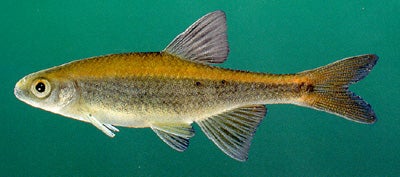BROADSTRIPE SHINER
SCIENTIFIC NAME: Pternotropis euryzonus
CHARACTERISTICS: The body of the broadstripe shiner is laterally compressed and deepest at the origin of the dorsal fin. Its head is small and somewhat triangular, with a blunt snout and a small, oblique mouth. A broad, dark lateral band extends from the tip of the snout to the base of the caudal fin. The lips and chin are dark. Breeding individuals have a bright orange caudal fin, as reported by Suttkus (1995). The lateral band is bluish gray and bordered above by a narrow orange stripe. The anterior tip of the dorsal fin is bright yellow-green, while the venter and lower flanks are pale. A clear "window" in the center of the caudal fin of large individuals is a distinguishing character and is not found in the similar sailfin shiner, Pteronotropis hypselopterus. Also, in breeding males of P. euryzonus, the outer margin of the extended dorsal fin is convex, with the anterior rays of the depressed dorsal fin equal to or slightly longer than the posterior rays. In P. hypelopterus this margin is concave or straight, with the anterior rays shorter than the posterior rays.
ADULT SIZE: 1.6 to 2 in (40 to 50 mm)
DISTRIBUTION: Pteronotropis euryzonus is endemic to the middle section of the Chattahoochee River drainage in Alabama and Georgia. Individuals have been collected from several western tributaries to the Chattahoochee in Alabama.
HABITAT AND BIOLOGY: The broadstripe shiner is typically found in small, clear streams (sometimes in blackwater streams) and is commonly associated with log snags or aquatic vegetation over substrates of sand, clay, silt, or exposed bedrock. It has not been collected sympatrically with the sailfin shiner. Spawning most likely occurs from May through July. It is presumably a drift feeder, consuming adult and larval insects and detritus.
REMARKS: The type locality of the broadstripe shiner is Uchee Creek near Marvyn, Lee County, Alabama.
ORIGINAL DESCRIPTION: The broadstripe shiner was described by Suttkus in 1955.
ETYMOLOGY:
Pteronotropis means winged keeled back, referring to the enlarged dorsal fin of breeding males.
Eurzonus means broad zone, referring to the broad lateral band.
The copyrighted information above is from Fishes of Alabama and the Mobile Basin.






